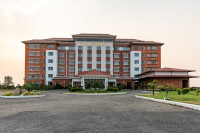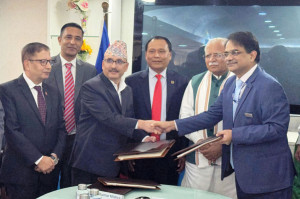Money
Paddy transplantation slows as monsoon takes a break
The pace of paddy transplantation has slowed in the Central and Eastern development regions due to fluctuations between the active and weak spells of the monsoon. However, the transplantation rate in the Far and Mid-Western and Western regions has been better than expected.
The pace of paddy transplantation has slowed in the Central and Eastern development regions due to fluctuations between the active and weak spells of the monsoon. However, the transplantation rate in the Far and Mid-Western and Western regions has been better than expected.
The Ministry of Agricultural Development said that farmers had finished transplanting paddy on 53.85 percent or half of the 1.55 million hectares of paddy fields as of Wednesday. In the same period last year, transplantation had been completed on 68 percent of the total cultivable land.
“The transplantation rate has slowed due to sparse rainfall or the break monsoon period during the mid-monsoon month of July,” said Ram Krishna Regmi, senior statistical officer at the ministry. “However, we expect the transplantation rate will exceed 70 percent within next week, the normal rate we have been observing.”
Regmi said that the transplantation rate is nothing to worry about because transplantation normally extends until mid-August in the Tarai, the country’s grain basket. In some places, paddy is planted till September when farmers sow the seeds directly instead of transplanting saplings.
The Tarai, which is the major paddy producing region in the country, contains 71 percent of its rice fields. The hilly region contains 25 percent and the mountain region 4 percent. This year, the monsoon entered Nepal on June 12, two days after the normal onset date. However, it was weak and only started to pick up pace from June-end allowing farmers to start transplanting paddy.
According to the ministry, the transplantation rate is higher in the Far Western Region with 93.23 percent of the total 176,560 hectares planted to paddy. In the same period last year, the Far Western Region had observed a transplantation rate of 96 percent.
Likewise, the transplantation rate in the Mid-Western and Western regions has been recorded at 59.71 percent of the 178,096 hectares and 70.33 percent of the 312,547 hectares respectively.
The Central and Eastern regions, however, have seen a low transplantation rate. According to the ministry, the transplantation rate in the Central and Eastern regions has been recorded at 38.37 percent of the 439,328 hectares and 39.62 percent of 445,938 hectares.
In the plains, Siraha and Dhanusha districts have recorded a transplantation rate of only 15 percent and 21 percent. Likewise, Sarlahi, Parsa, Bara, Mahottari and Dhanusha districts have also observed a low transplantation rate. The ministry’s statistics show that paddy transplantation in the mountain region has been completed on 69.20 percent of the 58,158 hectares while in the hilly region the rate is 67.22 percent of the 399,675 hectares.
In the Tarai, paddy transplantation has been completed on 48.15 percent of the 1.09 million hectares of paddy fields.
According to the ministry, transplantation has been completed in Jumla, Humla and Dolpa. Similarly, transplantation in Kailali and Kanchanpur has reached 90 percent and 98 percent respectively.
Weathermen have forecast a normal monsoon, bringing hope for another good year for paddy production after recording an all-time high harvest in the last fiscal year. The government has targeted to increase paddy output to 5.4 million tonnes this fiscal year from last year’s record 5.23 million tonnes.
A survey has revealed that bumper paddy harvests and a growth in the production of other key food grains helped the sector to make a recovery. Nepal’s farm sector saw a negative growth of 0.19 percent for the first time in the fiscal year 2015-16 due to summer and winter droughts.




 19.12°C Kathmandu
19.12°C Kathmandu














